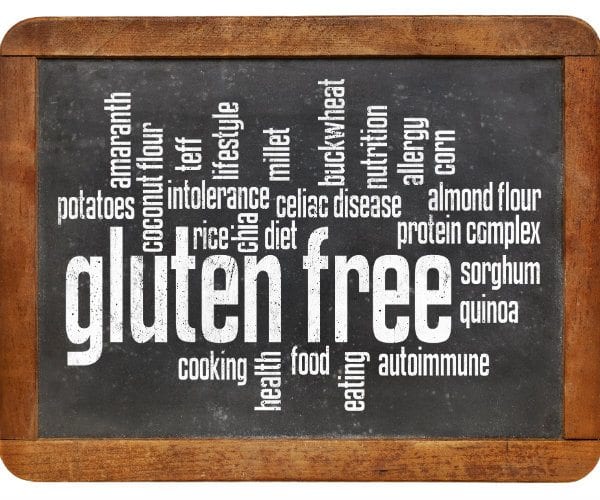Natural Health
Back Clinic Natural Health Functional Medicine Team. This is a natural approach to health care. It is a natural healing practice or a branch of alternative medicine that looks at nature for answers and explanations. There are a few Western forms of alternative medicine that NCCAM has classified as Biologically Based Therapies, as well as, Mind and Body Interventions used in stress management.
There is nothing magical about it. It is about natural healing therapies for prevention and healthy lifestyles. This means eating natural whole foods, nutritional supplements, physical exercise. This is nothing new, but it has evolved over the years within certain prevention parameters, and healthy lifestyles have proven to work repeatedly. There is nothing anti-intellectual or anti-scientific about it. All health, wellness, illness, and healing can be positively affected by simple and inexpensive natural therapies.

by Dr Alex Jimenez DC, APRN, FNP-BC, CFMP, IFMCP | Gluten Free Diet, Natural Health, Wellness
More and more people are following a gluten-free diet, but if they have no medical reason to do so they could actually be risking their health, a top expert says.
“The evidence is mounting against any health benefits from a gluten-free diet for those people without a medical reason,” John Douillard tells Newsmax Health.
Gluten is a naturally occurring protein present in cereal grains, especially wheat, which is responsible for the elastic texture of dough.
Traditionally, gluten was considered harmless unless eaten by people with celiac disease, whose digestive systems are unable to handle it.
But recently the idea of eating gluten-free has caught on, and the number of people following such a diet tripled in the five years between 2009 and 2014, while the number of those with celiac disease remained stable, research shows.
On the other hand, a pair of large studies, published in the past few months, has found those people who eat little gluten could be at risk of developing coronary heart disease, as well as diabetes.
Douillard is a chiropractor, certified addiction professional, and the author of “Eat Wheat,” along with six previous health books.
An expert in the field of natural heath, he is also former player development director and nutrition counselor for the New Jersey Nets NBA team. He has also appeared on the Dr. Oz Show, and featured in many national publications.
Here are excerpts from his recent interview with Newsmax Health.
Q: How did you get interested in gluten?
A: People would come to me with digestive problems and I’d tell them to get off wheat and they’d feel better for a short time, but after awhile, their problems would return. The same thing happened with dairy, or nuts. The problem wasn’t actual these specific foods. But, as the medical profession started making medical recommendations to get off of wheat, people began treating it like a poison.
Q: Who should not eat gluten?
A: People with celiac disease shouldn’t eat wheat, but that’s only about 1 percent to 3 percent of the population. There also may be those that don’t have celiac disease, but say they are sensitive to it, so they may be right to avoid it. But that’s an estimated 2 percent to 13 percent of the population. This leaves a third of the population that eliminated gluten from their diet under the misperception it is unhealthy. They are the ones missing out on the benefits of wheat.
Q: How did the idea that gluten is bad catch on?
A: Originally, people with celiac disease were told to avoid gluten but the idea caught on that it was good for other people as well, and now gluten-free has become a buzzword and it’s grown into a $16 billion industry. They’re even put “gluten free” on foods that never had any gluten in them, like yogurt.
Q: What’s the problem with gluten?
A: People who promulgate a gluten-free diet contend we aren’t genetically capable of eating gluten but that’s wrong. The University of Utah did a study that found evidence of wheat and barley in the teeth of ancient humans 3 ½ million years ago. The Paleo diet says to avoid grains, but if you talk to anthropologists, you’ll find out there’s nothing Paleo about this. Ancient humans gathered wheat berries to fuel them for the whole day. Most experts agree we didn’t start cooking out own meat until 500,000 years ago, so we had wheat in our teeth millions of years before that.
Q: What are the gluten-free people missing out on?
A: In addition to new studies that show wheat may lower diabetes and heart disease risk, wheat is a natural probiotic, and people who don’t eat it have less good microbes in their microbiome and more bad ones. They also are more likely to have weaker immune systems, because research finds eating the indigestible part of wheat helps to strengthen to strengthen it. In addition, people who follow the MIND Diet and the Mediterranean diet, both which permit whole grains, reduce their risk of Alzheimer’s disease.
Q: If it’s not gluten, what is the problem with the way we eat?
A: The problem is our reliance on processed foods. One study showed that our reliance on processed food increases metabolic syndrome (the condition that hikes heart disease and diabetes risk) by 141 percent. On the other hand, eating whole gains and whole wheat reduced it by 38 percent. So it’s processed foods we need to eliminate from our diet.
Here are Douillard’s 5 tips to digest gluten more easily:
1. Choose bread with only these ingredients: Organic whole wheat, water, salt, and an organic starter.
2. Sprouted soaked breads typically found in the refrigerator section are much easier to digest.
3. Avoid any bread or any packaged foods with cooked or heated vegetable oils. These are preservatives and indigestible.
4. Think seasonal eating. Eat more grains in the fall when they are harvested and less in the spring and summer.
5. Start your day with a beet, apple, and celery drink to amp up your digestive strength and spice your food with spices such as: ginger, cumin, coriander, fennel, and cardamon.

by Dr Alex Jimenez DC, APRN, FNP-BC, CFMP, IFMCP | Natural Health, Wellness
Women who are at least 35 years old when they give birth are much more likely than younger mothers to experience a variety of major pregnancy complications, a recent study confirms.
While previous research has linked what’s known as advanced maternal age to problems like high blood pressure and diabetes during pregnancy and a higher risk of death and severe complications for babies, the current study offers fresh insight into the severe health issues faced by older mothers, said lead study author Dr. Sarka Lisonkova.
“This is important for counseling women who contemplate delaying childbirth to their forties,” Lisonkova, of the University of British Columbia Children’s and Women’s Health Center in Vancouver, said by email. “While a delay of childbirth by a few years does not make a large difference in the early thirties, a few years delay in the late forties increases the risks significantly.
For the study, researchers examined data on all singleton births to 828,269 women in Washington State from 2003 to 2013.
After adjusting for other factors that can influence pregnancy outcomes like whether it’s a first-time pregnancy or if women are obese or used assistive reproductive technology, researchers compared age-specific rates of maternal death and severe complications like obstetric shock or amniotic fluid entering the mother’s bloodstream.
Compared with mothers aged 25 to 29, women aged 35 to 39 were 20 percent more likely to have severe complications, and the odds were more than quintupled for women 50 and older, researchers report in PLoS Medicine.
Women 35 and older were also eight times more likely to have amniotic fluid enter their bloodstream, a complication that can cause a life-threatening allergic reaction, the study found.
Mothers 40 and older were almost 16 times more likely to have kidney failure and almost three times more likely to have obstetric shock, when organs don’t get enough blood and oxygen, the study found. These women were also almost five times more likely to either have complications from interventions done to help deliver the baby or be admitted to intensive care units.
The study wasn’t a controlled experiment designed to prove how maternal age directly influences the odds of complications. Researchers also didn’t have enough cases to determine how age directly influences maternal deaths.
Even so, the findings add to evidence linking advanced maternal age to a higher risk of problems for mothers and babies, said Dr. Nanette Santoro, a researcher at the University of Colorado School of Medicine in Aurora who wasn’t involved in the study.
While many of these problems can be managed surgically, the study highlights some rare complications that are harder to treat and can be fatal like renal failure and amniotic fluid entering the bloodstream, Santoro said by email.
“Based on this study and others, the ideal age to get pregnant is between 25 and 29 years,” Santoro said. “Since we’ve just entered the first era in human history where the U.S. birth rate is higher for women aged 30 to 35 than for women aged 25 to 29, we will be seeing more aged-related risks to women who conceive at later ages.”

by Dr Alex Jimenez DC, APRN, FNP-BC, CFMP, IFMCP | Natural Health, Wellness
A new enzyme pill could be a game changer for gluten-sensitive people, according to the authors of a new study.
The enzyme breaks down gluten in the stomach and prevents most of it from reaching the small intestine. So it could allow gluten-sensitive people to eat small amounts of the protein (found in wheat and other grains) without suffering consequences such as bloating, diarrhea, and abdominal pain.
For the study, the researchers tested the effects of an enzyme called aspergillus niger-derived prolyl endoprotease (AN-PEP) in 18 patients with gluten sensitivity. Each participant ate a serving of oatmeal with two gluten-containing wheat cookies along with either a high- or low-dose of AN-PEP or a placebo pill.
Researchers then measured gluten levels in the stomach and small intestine over a three-hour period.
In both the high- and low-dose AN-PEP groups, the researchers found that AN-PEP reduced levels of gluten in the stomach by 85 percent compared to placebo.
They also found that the enzyme reduced gluten levels in the duodenum (the first part of the small intestine) by 81 percent in the high-dose group and by 87 percent in the low-dose group.
The findings were presented at Digestive Disease Week 2017, the largest international gathering of experts from the fields of gastroenterology, endoscopy, hepatology, and gastrointestinal surgery.
“This substance allows gluten-sensitive patients to feel safer, for example, when they are out with friends at a restaurant and can’t be sure whether something is 100 percent gluten-free,” says Dr. Julia König, Ph.D., the study’s lead author and post-doctoral research fellow at the School of Medical Sciences at University of Örebro, Sweden.
“Since even small amounts of gluten can affect gluten-sensitive patients, this supplement can play an important role in addressing the residual gluten that is often the cause of uncomfortable symptoms.”
Previous research has demonstrated that AN-PEP can break down gluten when it is combined with a liquid meal and administered through a feeding tube. The new study is the first to study the effects of AN-PEP tablet in combination with a normal meal.
“Studies show that even when following a gluten-free diet, unintentional gluten intake can still occur, depending on how strict a gluten-free dieter is,” says König.
“Our results suggest that this enzyme can potentially reduce the side effects that occur when gluten-sensitive individuals accidentally eat a little gluten. We are not suggesting that AN-PEP will give these individuals the ability to eat pizza or pasta, sources of large amounts of gluten, but it might make them feel better if they mistakenly ingest gluten.”
Gluten is a protein found in grains such as wheat, rye, and barley, as well as medicines, vitamins, and supplements.
In addition to gastrointestinal problems, gluten sensitivity is associated with symptoms such as fatigue, muscle cramps, and leg numbness.
Despite some similarities, gluten sensitivity is different from celiac disease, a serious, inherited auto-immune disorder caused by gluten exposure. Unlike people with celiac disease, those with gluten sensitivity do not develop gluten antibodies and their immune systems do not mistakenly attack and damage their small intestines.
According to the National Foundation for Celiac Awareness, about 18 million Americans are affected by non-celiac gluten sensitivity, also known as gluten intolerance.
Gluten sensitivity is poorly understood. Because there are no specific tests to diagnose the condition, doctors must rule out other possible causes of a patient’s symptoms such as celiac disease and wheat allergy.
To confirm gluten sensitivity, doctors usually place patients on a diet that eliminates gluten to see if their symptoms improve. This is followed by an “open challenge” (a monitored reintroduction of gluten-containing foods) to see if their symptoms worsen.
König notes that her team did not test the enzyme on celiac disease patients, because even small amounts of gluten can cause long-term harm in these individuals.
Because of that, she does not recommend celiac patients view this enzyme as a way to start eating any gluten.

by Dr Alex Jimenez DC, APRN, FNP-BC, CFMP, IFMCP | Natural Health, Wellness
As we move into summer many of us will be heading outdoors to make the most of the longer, sunnier days. However, we’re not the only ones who like warm weather, and for those who might be planning a picnic the higher temperatures can provide the perfect environment for bacteria to thrive. To ensure your outdoor event is memorable for all the right reasons, here we’ve put together some tops tips for food safety when dining al fresco.
Marinate safely
Marinate foods in the refrigerator before you leave for your picnic — never on the way or outdoors. In addition, if you plan to use some of the marinade as a sauce on the cooked food, reserve a portion separately before adding the raw meat, poultry, or seafood — do not reuse marinade.
Keep cold food cold
When transporting your food from home to your destination, keep cold food stored at 40 °F / 4.5 °C and below to prevent bacterial growth. Place cold food in a cooler with ice or frozen gel packs, and remember that cold meat, poultry, and seafood may be packed while still frozen so that they stay colder longer.
Keep things clean
Wash all your produce before you leave, and once at the picnic site clean your table, any barbecue equipment, and utensils before and during food preparation. If you have access to running water, use a water jug, some soap, and paper towels, or use moist disposable towelettes for cleaning your hands.
Cook food thoroughly
If barbecuing, cook food thoroughly to kill germs that cause food poisoning, and serve food while it is hot. Never let your picnic food remain in the “Danger Zone” — between 40 °F / 4.5 °C and 140 °F / 60 °C — for more than 2 hours, or 1 hour if outdoor temperatures are above 90 °F / 32 °C. This is when bacteria in food can multiply rapidly, and lead to illness.
Prevent “cross-contamination”
Don’t reuse plates or utensils when serving food, as serving cooked food on plates that have held raw meat, poultry, or seafood will allow bacteria to spread. Instead, make sure you have packed enough plates and utensils or wash what you need in hot, soapy water before using.
Take care with leftovers
If you have leftover cooked food refrigerate it within two hours. Once home reheat leftover food thoroughly to above 167 °F / 75 °C before eating.
For more information on how to stay safe and healthy this summer head to the websites of the World Health Organization, the Centers for Disease Control and Prevention, and FDA.gov.

by Dr Alex Jimenez DC, APRN, FNP-BC, CFMP, IFMCP | Natural Health, Supplements, Wellness
Calcium is an essential mineral found in foods and dietary supplements. Its best-known benefit is building and maintaining strong bones, and slowing bone loss. But it plays a critical role in heart health, nerve transmission, and muscle contraction.
Which calcium supplements are the best, most effective, and budget-friendly?
A new review published by ConsumerLab.com — a leading provider of consumer information and independent evaluations of products that affect health and nutrition — aims to answer those questions by ranking the best available supplements on the market.
The organization’s Calcium Supplements Review rates 27 products evaluated by the group.
Among the findings:
- All 27 products contained the listed amount of calcium. But one product was not approved because it did not contain the listed amount of magnesium and also was contaminated with lead. A second product – labeled as “fast dissolving” – was not approved because it did not dissolve quickly enough.
- The other 25 products all had consistently high quality.
- Prices varied widely, ranging from 4-80 cents for a 500 mg dose of calcium.
Based on the organization’s research findings, the review’s authors identified a Top Pick for each of nine categories. To be a Top Pick, a supplement had to pass ConsumerLab’s tests of quality, provide calcium at a reasonable price, contain a reasonable dose, and offer a convenient formulation.
The nine Top Picks are:
Overall Top Pick. GNC Calcium Citrate, which provides 500 mg of calcium per two-caplet serving at a cost of 9 cents. This supplement is also the Top Pick in the “Calcium Only” category.
Calcium and Vitamin D. Bayer Citracal Petites, which provide 400 mg of calcium and 500 IU of vitamin D per two-capsule serving for 11 cents.
Children’s Calcium and Vitamin D. L’il Critters Calcium and D3, which provides 200 mg of calcium and 220 IU of vitamin D in two gummies for 10 cents.
Calcium and Magnesium. Finest Nutrition (Walgreens) Calcium, Magnesium and Zinc, which provides 999 mg of calcium and 399 mg of magnesium in three tablets for 17 cents.
Calcium, Vitamin D and Vitamin K. Viactiv Calcium Plus D, which provides 500 mg of calcium, 500 IU of vitamin D, and 40 mcg of vitamin K in one soft-chew pill for 10 cents.
Calcium, Vitamin D and Magnesium. Kirkland Signature (Costco) Calcium Citrate Magnesium and Zinc, which provides 500 mg of calcium, 800 IU of vitamin D, and 80 mg of magnesium in two tablets for 5 cents.
Children’s Products Containing Calcium, Vitamin D and Magnesium. ChildLife Liquid Calcium With Magnesium – Natural Flavor, which provides 252 mg of calcium, 100 IU of vitamin D, and 115 mg of magnesium per tablespoon for 34 cents.
Calcium, Vitamin D, Vitamin K and Magnesium. Jarrow Formulas Bone-Up, which provides 1,000 mg of calcium, 1,000 IU of vitamin D, and 350 mg of magnesium in three capsules for 47 cents. (Note: Because this supplement may contain unnecessarily high amounts of calcium and vitamin D, the report’s authors recommend taking a two-capsule dose instead.)
Most adults need 1,000-1,200 mg of calcium per day, from all sources. These include food, supplements, and an often overlooked source: calcium-containing antacids.
Because you may already be getting that amount from food alone, supplementation may be unnecessary. Rich dietary sources of calcium include dairy products, beans, and green-leafy vegetables. For example, just one cup of milk or yogurt provides a whopping 300-400 mg of calcium.
If you’re not getting the recommended amount of calcium from your diet, supplements can help. Multiple studies show that 1,000-2,000 mg per day of calcium (usually as calcium citrate) in combination with 400-800 IU per of vitamin D can slow bone loss in postmenopausal women. Research shows that supplementation may be especially useful in in postmenopausal women who have been prescribed hormonal therapy after undergoing a hysterectomy.
The official tolerable upper limits for calcium are 2,500 mg per day for children ages 1-8, 3,000 mg for those ages 8-18, which falls to 2,000 mg for those over 50. But much lower amounts, usually from supplements, have been associated with risks for adults.
It’s rare to get toxic amounts of calcium from food alone. In fact, a high dietary intake of calcium is associated with many good effects. But excess calcium from supplements is associated with a wide range of ill effects.
“Be careful!” the authors write. “Calcium from supplements may increase the risk of cardiovascular disease if you get too much from supplements [over 1,000 mg per day] or if you already get enough calcium from your diet.”
A high calcium intake from supplements also may increase the risk of:
- Prostate cancer.
- Kidney stones.
- Dementia.
Calcium supplements also may impair the absorption of thyroid hormone and antibiotics in the fluoroquinolone class.
If you take calcium supplements, the researchers offer these tips.
- Since your body can’t absorb more than 500 mg of calcium at a time, it’s best to take only a few hundred milligrams at a time, and no more than 1,000 mg total per day.
- If your supplement includes vitamin D and/or vitamin K, taking it with the meal that includes the most fats and oils may enhance absorption.
- Avoid taking calcium supplements and other mineral supplements together because the calcium may reduce their absorption.

by Dr Alex Jimenez DC, APRN, FNP-BC, CFMP, IFMCP | Natural Health, Wellness
New research has found yet another way that the current levels of air pollution is impacting our health, this time by disrupting our sleep.
Presented at the ATS (American Thoracic Society) 2017 International Conference, the findings suggest that high levels of air pollution not only affect heart health, breathing, and lung function, as found in previous studies, but also sleep quality.
For the new research the team analyzed data from 1,863 participants with an average age 68, who were taking part in the Multi-Ethnic Study of Atherosclerosis (MESA) and both of MESA’s Sleep and Air Pollution studies.
The study looked at the effects of two of the most common air pollutants — NO2, a traffic-related pollutant gas, and PM2.5, or fine-particle pollution — and estimated exposure to air pollution at each participant’s home both one year and five years into the study.
Participants wore a wrist device for a seven-day period to measure their sleep and activity, and calculate “sleep efficiency” — a measure of the percentage of time in bed spent asleep vs. awake.
After finding that 25 percent of participants had a sleep efficiency of 88 percent or less, the team decided to look at whether exposure to pollution was impacting the sleep of this low efficiency group.
The group was divided into four according to levels of pollution, with the team comparing those who experienced the highest levels of pollution with those who experienced the lowest levels.
After taking into account various factors including age, body mass, obstructive sleep apnea, race/ethnicity, income and smoking status, the results showed that those exposed to the highest levels of NO2 over five years had an almost 60 percent increased chance of having low sleep efficiency compared to those with the lowest NO2 levels.
Those exposed to the highest levels of small particulates (PM2.5) had a nearly 50 percent increased chance of having low sleep efficiency.
Lead author Martha E. Billings, commented that, “We thought an effect was likely given that air pollution causes upper airway irritation, swelling and congestion, and may also affect the central nervous system and brain areas that control breathing patterns and sleep.”
However, she also added that further research is needed in order to look at an association between sleep and other air pollutants not included in this study, as well as how pollutants may disrupt sleep patterns. Another possibility is that it is traffic noise rather than pollutants that is contributing to poor sleep quality.
“There may be acute sleep effects to short-term exposure to high pollution levels as well, but we lacked the data to study that link,” added Dr. Billings.

by Dr Alex Jimenez DC, APRN, FNP-BC, CFMP, IFMCP | Natural Health, Wellness
From depression and daytime sleepiness to difficulty concentrating, new Australian research suggests that women are more sensitive than men to the effects of sleep disorders in their daily lives.
Researchers at the SleepGP clinic in Coolangatta, Australia, set out to investigate how men and women may be affected differently by sleep disorders in their day-to-day lives.
Scientists studied 744 patients, who received sleep-related healthcare from seven private general practices in Australia between 2013 and 2015. They were assessed via several sleep-related tests, including the Epworth Sleepiness Scale (ESS) and other questionnaires.
The scientists found that women were more likely to have sleep disorders associated with daytime sleepiness (49% compared to 36.9 % for men). Women were also more likely to report an increased burden of symptoms linked to sleepiness.
The study found that women were more likely to feel excessively tired or depressed, have difficulty concentrating or remembering things, and have more trouble sleeping at night.
In addition, male snoring was more likely than female snoring to force bed partners to sleep in different rooms.
The study results are published in the May 15 issue of the Journal of Clinical Sleep Medicine.
The study is available here: http://www.aasmnet.org/jcsm/ViewAbstract.aspx?pid=31011







